Shifting from a Linear Economy to a Circular Economy through Micronization

In today’s world, the linear economy model, with its take-make-dispose approach, is proving to be unsustainable. As resources dwindle and waste accumulates, the need for a more circular and regenerative economic model becomes evident. One promising solution that paves the way for this transition is the utilization of micronization techniques. By reducing particle size and unlocking new opportunities for waste valorization, micronization holds the potential to transform our linear economy into a circular one.
Micronization plays a vital role in maximizing resource efficiency, a cornerstone of the circular economy. Through micronization, waste materials such as plastics, metals, minerals, and organic compounds can be processed and transformed into valuable resources. Reducing the particle size enhances the properties of waste materials, making them suitable for new applications and extending their useful life. Moreover, micronization facilitates waste minimization by improving the efficiency of subsequent treatment processes. Smaller particle sizes enable better recycling, composting, or reutilization of waste materials, diverting them from landfill or incineration. By extending the lifecycle of materials and reducing waste generation, micronization plays a crucial role in minimizing the environmental impact associated with resource consumption and disposal.
Micronization serves as a catalyst for waste-to-value pathways within the circular economy. The micronized particles obtained from waste materials can be reintroduced into the production cycle as inputs for manufacturing processes or as ingredients for various industries. Additionally, micronization promotes product innovation by enabling the development of novel materials and value-added products. The fine particles obtained through micronization possess unique properties that can be leveraged for new applications, fostering creativity, and driving sustainable innovation across industries. One specific solution, AggrePlex, obtains old waste glass and transforms it into pozzolan which facilitates better concrete performance while being environmentally friendly.
Micronization provides a powerful tool to drive the shift from a linear economy to a circular economy. By maximizing resource efficiency, driving waste-to-value pathways, promoting energy efficiency, and minimizing waste generation, micronization offers a sustainable path forward. As we harness the potential of micronization and adopt circular economy principles, we can unlock new opportunities for economic growth, reduce our reliance on virgin resources, and create a more sustainable and regenerative future for generations to come. The time for a circular economy powered by micronization is now, and together, we can pave the way for a more prosperous and sustainable world.








